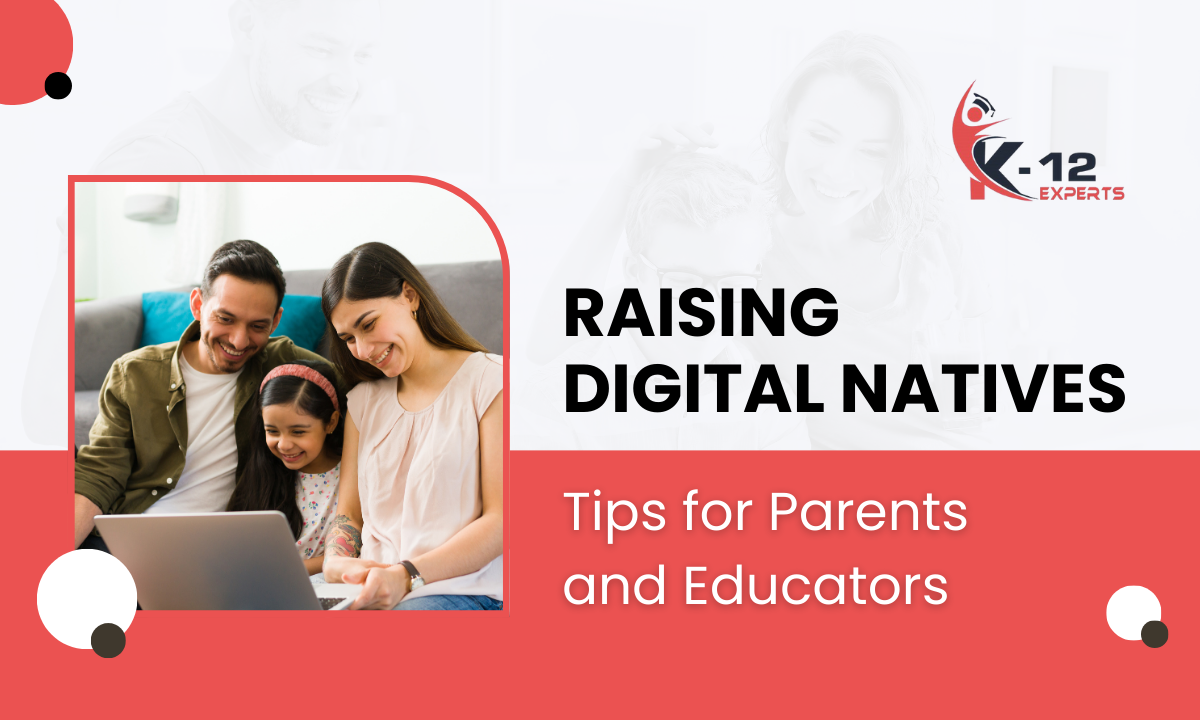You’re helping shape the online habits of the next generation, whether you’re a parent, educator, or both. As a role model, you set the tone for how kids interact with technology. By modeling good digital behavior, you show them what’s acceptable and what’s not. But with the digital landscape constantly evolving, it’s a challenge to stay ahead of the curve. What are the most effective strategies for teaching online safety, managing screen time, and fostering healthy online relationships? Discover the essential tips you need to raise confident, responsible digital natives who thrive in a rapidly changing world.
Set a Good Digital Example

As a parent, setting a good digital example begins with being mindful of your own online behavior, because your kids are likely watching – and mimicking – your every move.
You play a significant digital role in shaping their online habits, so it’s crucial to model the behavior you want to see.
Be intentional about setting personal boundaries, such as not checking work emails or taking calls during family time.
Your kids will notice and learn from your actions.
By being mindful of your online behavior, you’ll show your kids that technology can be a tool, not a constant companion.
Monitor and Limit Screen Time
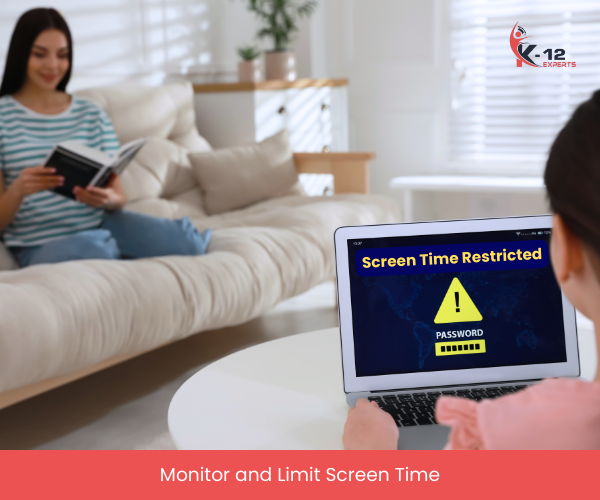
By keeping tabs on how much time your kids spend staring at screens, you can help them avoid the negative effects of excessive screen time and develop a healthier balance between technology use and other activities.
To do this, set screen time goals for your kids and track their progress. You can use built-in parental controls or apps to monitor and limit their screen time.
By setting screen time goals, you can help your kids develop healthy digital habits.
Establish screen-free zones and times in your home,
such as during meals or before bedtime.
Be consistent in enforcing these limits and offer alternative activities to help them develop a diverse range of interests.
This will help your kids have a balanced and healthy relationship with technology.
Teach Online Safety and Security

To safeguard your kids’ digital experiences, it’s crucial to teach them the fundamentals of online safety and security, starting with basic precautions such as creating strong passwords and being cautious with online interactions.
You need to cover Cyber Security Basics, including how to spot phishing scams, avoid suspicious downloads, and use two-factor authentication.
Teach your kids to think carefully before sharing personal info or photos online, as this will impact their Digital Footprint Management. Encourage them to use reputable websites and apps and report any unusual activity to you.
Encourage Critical Thinking Skills
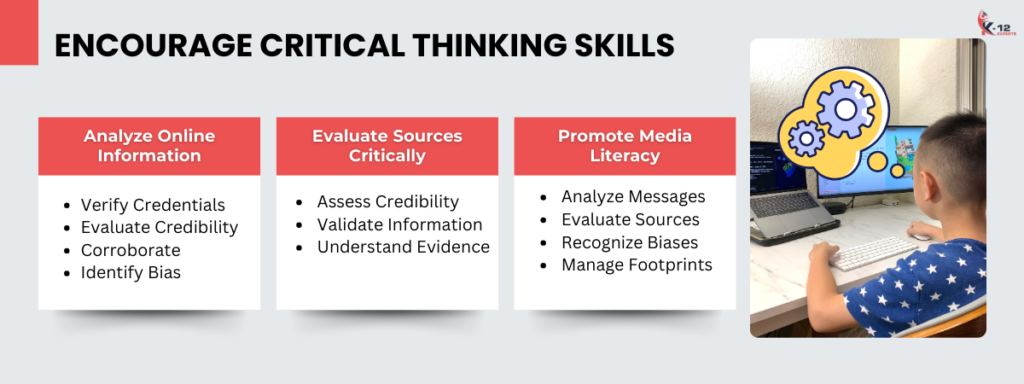
As you guide your child through the vast digital landscape, it’s vital that you encourage them to think critically about the information they encounter.
You’ll want to teach them how to analyze online information, evaluate sources, and identify biases so they can make informed decisions about what they believe and share online.
Analyze Online Information
When traversing the vast online landscape, you must develop a critical eye to distinguish between credible sources and misinformation, guaranteeing the information you consume is both accurate and trustworthy.
To analyze online information effectively, consider these key factors:
Verify author credentials: Certify that the author is an expert in the field they’re writing about.
Evaluate source credibility: Research the publication’s reputation for producing unbiased and factual content.
Look for corroboration: Cross-check information with multiple sources to increase confidence in its accuracy.
Be aware of information bias: Recognize any language or framing that intentionally promotes a specific agenda.
Evaluate Sources Critically
By developing a habit of critical thinking, you build on the skills learned in analyzing online information, fostering a deeper understanding of not just what sources say but also why they say it.
As you evaluate sources critically, you start to weigh source credibility and potential biases. You learn to look beyond the surface level and assess the evidence provided.
Information validation becomes second nature, and you begin to recognize the importance of verifying facts before accepting them as true.
By doing so, you develop a more nuanced understanding of the information you consume, and you’re better equipped to make informed decisions and form well-rounded opinions.
This skill will serve you well in all aspects of life, both online and offline.
Promote Media Literacy
Media literacy becomes your strongest ally in traversing the complex digital landscape, empowering you to dissect the messages, motives, and methods behind the information you encounter.
As you promote media literacy, you’re teaching digital natives to think critically about the information they consume and create. This includes evaluating online! sources, identifying biases and misinformation, and managing their digital footprints.
To get started, focus on these key areas:
Analyzing messages: Help them break down the purpose and intent behind a message.
Evaluating sources: Teach them to assess the credibility and reliability of online sources.
Recognizing biases: Guide them in identifying biases and perspectives in digital content.
Managing digital footprints: Show them how to control their online presence and maintain a positive digital reputation.
Foster Healthy Online Relationships

Your child’s online relationships have a profound impact on their emotional well-being, self-esteem, and social skills, making it crucial that you guide them in fostering healthy connections in the digital world.
As a parent or educator, you play a significant role in helping them develop emotional intelligence and online etiquette.
Teach your child to be respectful and empathetic in their online interactions, and encourage them to ponder the feelings and perspectives of others.
Set clear expectations and guidelines for their online behavior, and model healthy online relationships yourself.
By doing so, you’ll help your child build strong, positive relationships that will benefit them throughout their lives.
This guidance will also help them navigate the complexities of online communication with confidence and kindness.
Develop Digital Literacy Skills

Teaching your kids digital literacy skills is crucial in today’s digital age.
By teaching them online safety best practices, effective digital tool use, and critical thinking exercises, you’ll empower them to make informed decisions and stay safe online.
As you guide them, you’ll also help them develop essential skills for succeeding in today’s technology-driven world.
Online Safety Best Practices
Developing digital literacy skills is essential for kids to navigate the online world safely and effectively, and it starts with teaching them online safety best practices.
As a parent or educator, you play a pivotal role in shaping their digital citizenship and online etiquette.
To get started, focus on these essential tips:
Set clear boundaries: Establish rules and guidelines for online behavior, including what’s acceptable and what’s not.
Monitor online activity: Keep an eye on what your child is doing online and be aware of potential risks.
Teach critical thinking: Encourage kids to think critically about online content and sources.
Practice online kindness: Foster a culture of kindness and respect online, just as you’d offline.
Effective Digital Tool Use
Mastering a range of digital tools is a crucial aspect of raising digital natives, as it enables kids to create, communicate, and collaborate effectively in an increasingly technology-driven world.
You want your kids to be adept at using tools that facilitate collaborative learning, such as online discussion boards, group project management software, and multimedia presentation tools.
This requires you to model effective digital tools yourself and provide opportunities for your kids to practice using these tools.
By doing so, you’ll help them develop the skills they need to excel in today’s digital landscape while also promoting good digital citizenship.
Encourage them to experiment with different tools and find what works best for them, and you’ll soon be raising savvy digital natives.
Critical Thinking Exercises
As your kids become more comfortable using digital tools, incorporating critical thinking exercises into their online activities helps them evaluate information, identify biases, and make informed decisions in the digital world.
You can encourage critical thinking by presenting them with Brainstorming Challenges that require creative problem-solving. Lateral Thinking exercises can also help them think outside the box and consider alternative perspectives.
Encourage media analysis: Ask your kids to evaluate online articles, videos, or social media posts for bias and accuracy.
Use online puzzles and games: Engage your kids in interactive puzzles and games that require critical thinking and problem-solving.
Discuss online scenarios: Present your kids with hypothetical online scenarios and ask them to think critically about how to resolve them.
Role-play online interactions: Practice online interactions with your kids, such as responding to cyberbullying or online harassment.
Educate About Cyberbullying Risks
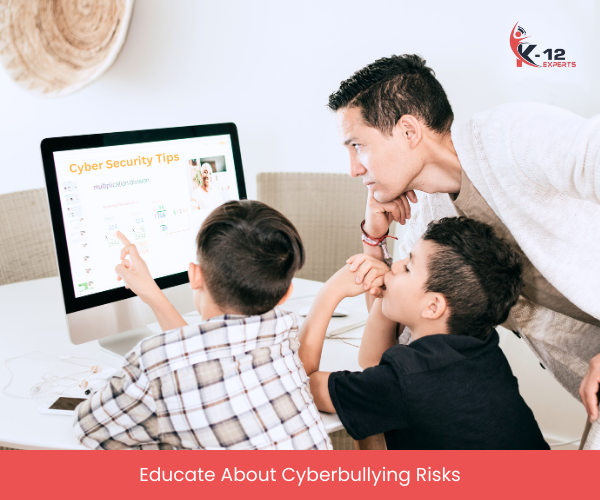
You need to talk to your kids about cyberbullying risks, including online harassment, stalking, and threats, as soon as they start interacting with others on the internet.
It’s vital to educate them on cyber violence prevention and online harassment detection to safeguard their safety.
Explain what constitutes cyberbullying, its effects, and how to identify it.
Discuss the importance of reporting incidents and how to do so.
Encourage your kids to be kind and respectful online, just as they’d in person.
Role-play different scenarios to help them develop the skills to handle difficult situations.
By starting this conversation early, you’ll empower your kids to navigate the digital world confidently and safely.
Stay involved and engaged in their online activities to reinforce these lessons.
Create a Family Media Plan
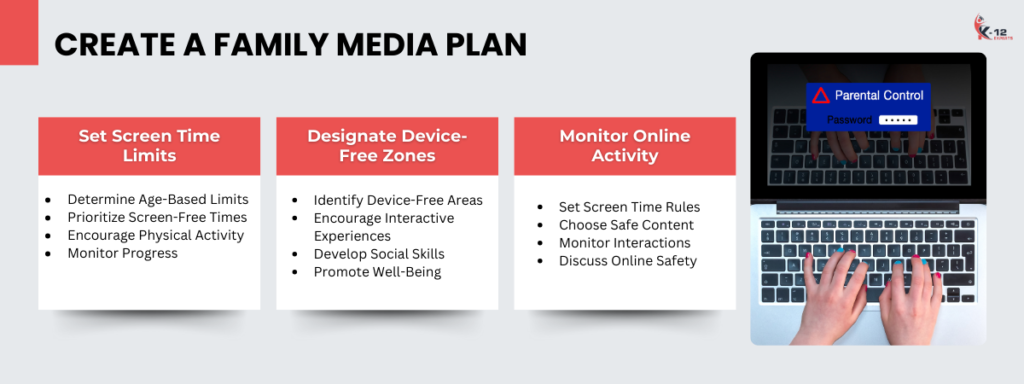
As you navigate the complex world of raising digital natives, creating a family media plan is a vital step in setting boundaries and promoting healthy tech habits.
By establishing clear rules and guidelines, you can help your kids develop a balanced relationship with screens and devices.
Now, it’s time to get specific – let’s explore the essential elements of a family media plan, including setting screen time limits, designating device-free zones, and monitoring online activity.
Set Screen Time Limits
Setting screen time limits is a crucial step in helping your family develop healthy media habits, and creating a family media plan is the key to making those limits stick.
By setting boundaries around device use, you’re giving your kids the gift of screen freedom – the freedom to play, create, and relax without the constant glow of a screen.
To create a successful family media plan, follow these steps:
Determine age-based limits: Set limits based on your child’s age and individual needs.
Prioritize screen-free times: Designate specific times of the day when screens are off-limits.
Encourage physical activity: Make time for outdoor play, sports, or other activities that get your kids moving.
Monitor progress: Regularly review your child’s screen time to confirm they’re staying within the limits you’ve set.
Designate Device-Free Zones
Device-free zones are a powerful tool in your family media plan, helping your kids disconnect from screens and reconnect with the world around them.
By designating specific areas or times as device-free, you’re setting clear boundaries and encouraging more interactive and engaging experiences.
Start by identifying family spaces that should be device-free, such as the dinner table or living room.
Establishing device-free zones helps your kids develop essential social skills such as communication and empathy.
It also allows them to set personal boundaries and prioritize activities that promote mental and physical well-being.
Monitor Online Activity
Regularly monitoring your kids’ online activity is crucial to ensuring their digital safety and well-being, so you need a solid plan in place to track their screen time and online interactions.
By setting up parental controls, you can limit their access to certain websites, apps, and online content.
Establishing online boundaries also helps them understand what’s acceptable and what’s not.
Set screen time limits: Establish rules for when and how long your kids can use devices.
Choose safe websites and apps: Select suitable online content for their age and interests.
Monitor online interactions: Keep an eye on their social media and online conversations.
Have open conversations: Regularly discuss online safety and digital citizenship with your kids.
Promote Responsible Social Media Use

By modeling healthy online behaviors and having open conversations, you can help your kids develop the critical thinking skills they need to navigate social media responsibly.
You’re their most important influence, and they’re watching how you interact online. Be mindful of the social norms you’re demonstrating – are you kind to others, or do you get into online arguments?
Make sure you’re providing the parental guidance they need to understand what’s acceptable and what’s not. Encourage them to think before they post, considering how their words might impact others.
Stay Up-To-Date With Digital Trends

To keep pace with your kids’ ever-evolving digital landscape, you need to educate yourself on the latest apps, platforms, and online trends that are capturing their attention. By staying informed, you’ll be better equipped to guide them in managing their digital footprint and making smart choices online.
There are four ways to stay current with tech trends:
Follow reputable tech websites and blogs: Stay up-to-date on the latest tech news and trends with websites like TechCrunch, Wired, and CNET.
Join online communities: Participate in online forums and social media groups where parents and educators share insights and advice on raising digital natives.
Attend workshops and conferences: Learn from experts and network with others who share your interests.
Explore new apps and platforms: Try out the latest apps and platforms your kids are using to understand their online world.
Frequently Asked Questions
How Can I Control Digital Distractions During Homework and Study Time?
You can control digital distractions during homework and study time by setting screen boundaries and establishing consistent study routines. Identify your most distracting apps and sites, and temporarily block or silence them to stay focused.
Can Digital Natives Still Develop Good Handwriting Skills in a Keyboard Age?
You’re developing your writing skills, but can you still master handwriting in a keyboard age? You’ll find that prioritizing handwriting importance and balancing it with keyboard ergonomics will help you cultivate good handwriting skills.
At What Age Should Children Have Their First Mobile Phone or Device?
You’ll face this question eventually: At what age should your kids have their first mobile device? Setting digital boundaries and teaching phone etiquette early can make a big difference as you decide what’s best for your child.
Can Excessive Screen Time Cause Physical Health Problems in Children?
“As you gaze into the screen’s mesmerizing glow, beware: excessive screen time can cast a shadow on your child’s physical health, increasing eye strain risks and fostering a sedentary lifestyle that threatens their overall well-being.”
How Can Parents Restrict Access to Certain Apps and Websites Effectively?
You can restrict access to certain apps and websites effectively by setting app restrictions on their devices and using online safety tools to monitor their online activity, helping you guarantee their digital well-being.
Conclusion
You’ve taken the first step in raising digital natives who are informed, responsible, and safe online.
Remember, ‘actions speak louder than words,’ so continue to model good digital behavior and stay engaged in your kids’ online lives.
By following these tips and staying up-to-date on the latest digital trends, you’ll empower your kids to navigate the online world with confidence and make a positive digital footprint that will serve them well for years to come.

